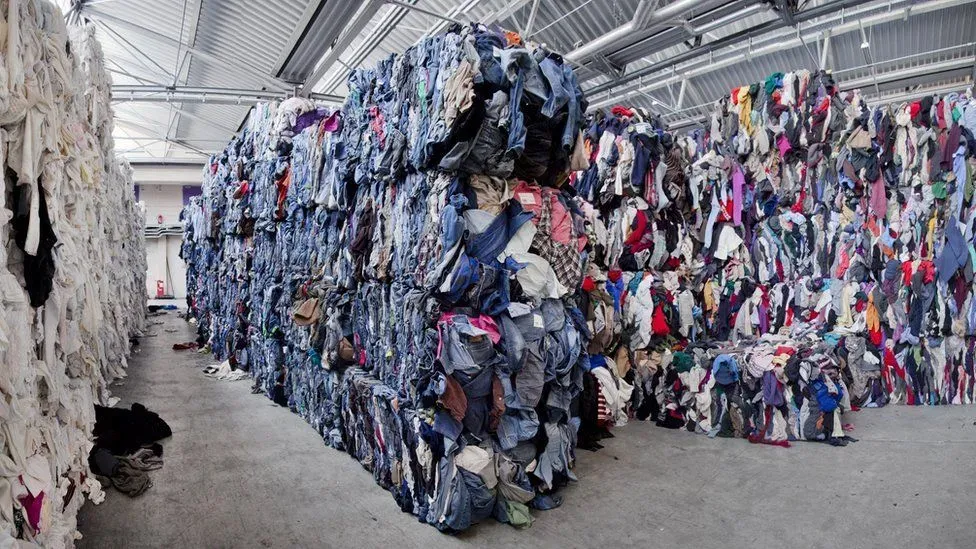Clothing recycling protests have emerged as a powerful response to the environmental challenges posed by fast fashion and growing textile waste. Activists are mailing worn-out garments back to retailers, shining a light on the inaction of brands that often overlook their responsibility for sustainable fashion. Recent movements have sparked public awareness about the realities of textile waste management and the detrimental fast fashion impact on our planet. With charity shops unable to accept damaged items and local councils opting for incineration, the protestors are demanding accountability from fashion brands for the disposal of their products. Through this grassroots initiative, consumers are reclaiming their power to advocate for recycling clothing and a greener future.
Protests centered around textile recycling are gaining momentum as the fashion industry faces scrutiny over its practices. Many individuals are sending back their damaged clothing to brands, raising questions about the sustainability of product disposal. Amidst the turmoil of ending fast fashion’s cycle, these protests serve as a clarion call, urging retailers to reconsider their impact on the environment. The actions taken by these activists not only highlight the issue of textile waste but also underscore the need for effective recycling solutions. As more consumers become aware of the ecological ramifications of their choices, the demand for a shift towards more responsible fashion practices intensifies.
The Impact of Fast Fashion on Clothing Waste
Fast fashion has drastically altered consumer behavior, leading to an explosion of textile waste. With retailers producing cheaper garments at an unprecedented rate, the allure of disposable apparel has resulted in consumers purchasing more clothes than ever before. The environmental repercussions are staggering, as these garments are often made from synthetic fibers that do not degrade well, adding significant amounts of textile waste to landfills. Consequently, the cumulative effect of fast fashion contributes heavily to pollution and resource depletion, making sustainable fashion a critical area of focus for consumers who are becoming increasingly aware of the climate crisis.
The rapid turnover of fashion trends also means that many clothes are discarded before they have reached the end of their usable life, leading to increased landfill waste. As the cycle of buying and throwing away continues, community resources, such as charity shops, are overwhelmed and unable to cope with the influx of worn clothing. This not only strains charitable donations but also raises questions about the ethics of fast fashion, as communities are left to deal with the consequences of an industry that prioritizes profit over sustainability.
Understanding Clothing Recycling Protests
Clothing recycling protests have gained momentum among environmentally conscious consumers frustrated with the current state of textile waste management. Initiatives such as the #TakeItBack campaign led by activists highlight the need for brands to take responsibility for the products they create, especially at the end of their lifecycle. By sending worn-out clothing back to retailers, activists aim to hold these brands accountable and encourage them to adopt sustainable practices for recycling clothing. Such protests underline the gaps within existing recycling programs that often fail to deliver on their promises of sustainability.
These protests serve as a significant reminder that many recycling schemes implemented by large fashion retailers, including those claiming to promote sustainable fashion, often fall short. Reports indicate that a significant portion of clothing donated through these programs is either incinerated or shipped overseas, raising ethical concerns about waste colonialism. Advocates for change argue that systemic shifts are required to make recycling clothing not just an option but a default practice in the industry. Therefore, clothing recycling protests play a key role in raising awareness and pushing for more transparent and effective solutions.
The Crisis in Charity Shops and Textile Recycling
Charity shops have long served as a vital resource for rehoming unwanted clothing, but they currently find themselves in a crisis due to the overwhelming volume of non-sellable items. With many stores now unable to accept damaged or unsalable items, the responsibility of managing textile waste has shifted back to consumers, who are left uncertain about where to send their old clothes. This dilemma is exacerbated by the rising costs of disposal for charities, forcing them to find alternative solutions, such as incinerating clothing or sending it overseas, rather than recycling it.
The impact of this crisis extends to the entire textile recycling sector, which is facing substantial financial pressures. As reported, many collectors and sorters are struggling to include damaged items in their profit margins. If this trend continues, we may see a significant reduction in the viability of textile recycling in the UK. Therefore, there is an urgent need for innovative solutions and policy changes that prioritize sustainable practices in the textile industry to prevent further environmental degradation.
The Role of Extended Producer Responsibility (EPR)
Extended Producer Responsibility (EPR) is an essential framework that holds manufacturers accountable for the lifecycle of their products, including their disposal. Advocates argue that implementing EPR in the fashion industry could shift the paradigm from reactive waste management to proactive sustainability, pushing brands to create more recyclable and sustainable clothing. With the European Union poised to mandate EPR for textiles, there is hope that similar legislation will follow in the UK, leading to more responsible industry practices.
The concept of EPR would not only empower consumers by providing them with clear options for disposing of their clothing sustainably but also foster innovation among textile producers to improve the recyclability of their fabrics. In essence, EPR encourages a circular economy where waste is minimized, and resources are used more efficiently. This approach aligns with the principles of sustainable fashion, promoting a system where environmental and social responsibility takes precedence over fast fashion business models.
Encouraging Community Participation in Textile Recycling
Community engagement is essential for driving the shift towards sustainable fashion practices. Initiatives that promote education on the importance of recycling clothing can significantly empower individuals to take action, be it through participation in local recycling events or advocating for policy changes. By fostering a culture of awareness around textile waste and recycling processes, communities can collectively tackle the issue and support local solutions that benefit both society and the environment.
Moreover, community support for local charities and innovative textile recycling programs can help reduce the burden on charity shops and promote sustainable practices within the fashion industry. When communities come together to recycle their clothing thoughtfully, they can significantly reduce waste and contribute to a larger movement toward sustainable fashion. Engaging local designers in creating upcycled items or hosting repair workshops further encourages a culture of sustainability within communities.
The Consequences of Textile Waste on the Environment
The sheer volume of textile waste generated by the fast fashion industry has far-reaching environmental consequences. Textile waste not only occupies valuable landfill space but also emits harmful greenhouse gases as it decomposes. Synthetic fibers, in particular, can release toxic materials into the soil and water supply, polluting ecosystems and harming wildlife. Furthermore, the chemicals involved in the textile manufacturing process often contribute to air and water pollution, exacerbating environmental issues.
Additionally, the high levels of water consumption associated with fabric production can lead to water scarcity, particularly in regions already suffering from limited resources. Sustainable fashion practices, which prioritize the reduction of textile waste, are not just beneficial for consumer ethics but essential for the health of our planet. Therefore, addressing the issue of textile waste is imperative if we aim to mitigate the negative environmental impact created by the fast fashion industry.
Consumer Accountability in Sustainable Fashion
As consumers, the power to influence the fashion industry’s practices is immense. The shift towards sustainable fashion necessitates a demand for more transparency and ethical manufacturing processes from brands. By choosing to purchase from companies that embrace sustainability and hold them accountable for their products, consumers can drive change in the direction of less waste and more responsible use of resources. Engagement with initiatives like clothing recycling protests can further amplify this call for accountability, forcing retailers to rethink their production practices.
The role of the conscious consumer has never been more critical. Decisions regarding clothing purchases should not only consider style and price but also the potential impact on the environment. Advocating for circular economy practices and actively participating in recycling efforts is a powerful way to contribute to global sustainability goals. By fostering informed purchasing decisions, consumers can play an integral role in shaping a more sustainable future and reducing the adverse effects of textile waste.
The Need for Innovative Recycling Solutions
The rapid increase in clothing waste highlights an urgent need for innovative recycling solutions within the fashion industry. Current recycling methods often fall short of being truly effective, especially when it comes to synthetic materials that dominate the market. The challenge lies in developing technologies and systems that can efficiently recycle mixed-fiber fabrics, preventing them from contributing to landfill waste. Investments in research and development could lead to breakthroughs in recycling methods, making it possible to convert old textiles into new, wearable garments.
Additionally, collaboration between fashion brands and recycling companies can help create closed-loop systems where materials are continually reused. By focusing on fiber-to-fiber recycling, the industry could significantly reduce its reliance on virgin resources and minimize environmental damage. As awareness increases around the importance of sustainable practices, designers and manufacturers who invest in innovative recycling solutions will likely gain a competitive edge, appealing to a growing demographic of eco-conscious consumers.
The Role of Public Awareness in Textile Waste Management
Public awareness campaigns are vital in educating consumers about the implications of textile waste and the importance of sustainable fashion practices. By sharing information about the environmental impact of clothing disposal and promoting the benefits of recycling initiatives, these campaigns can empower individuals to make more informed choices regarding their wardrobe. Highlighting successful case studies and community-based projects can also inspire collective action towards reducing textile waste.
Furthermore, initiatives that encourage dialogue between consumers and fashion brands can bridge the gap that often exists in understanding the complexities of sustainable production and textile recycling. By creating forums for discussion and feedback, brands can stay attuned to consumer needs and drive change in their practices. As consumers become more vocal about sustainability, the industry will be compelled to listen, adapt, and ultimately contribute to a more sustainable future.
Frequently Asked Questions
What are clothing recycling protests and how are they connected to sustainable fashion?
Clothing recycling protests are movements where consumers advocate for more sustainable practices in the fashion industry, often by returning worn-out or unsellable garments to brands. These protests highlight the urgent need for sustainable fashion solutions, particularly addressing textile waste caused by fast fashion’s impact on the environment.
How do clothing recycling protests address the issue of textile waste?
Clothing recycling protests draw attention to the growing problem of textile waste generated by the fast fashion industry. Activists return damaged or unsellable clothes to retailers, demanding accountability for their products’ lifecycle and advocating for real recycling options rather than incineration or overseas dumping.
What impact does fast fashion have on clothing recycling efforts?
Fast fashion significantly hampers clothing recycling efforts due to the low quality of materials used, which often leads to a higher rate of textile waste. This results in charity shops and recycling facilities struggling with unsellable items, as many fast fashion products are made to quickly fade or break down, exacerbating environmental concerns.
What strategies are used in clothing recycling protests to advocate for change?
Activists in clothing recycling protests utilize strategies such as mailing worn-out clothes back to retailers along with letters demanding sustainable solutions. This non-confrontational approach seeks to engage brands in discussions about their responsibility and encourages the adoption of more effective recycling programs.
What role does consumer activism play in clothing recycling protests?
Consumer activism plays a crucial role in clothing recycling protests by empowering individuals to hold brands accountable for their environmental practices. By participating in these protests, consumers push for systemic changes in how brands manage textile waste, advocating for sustainable fashion solutions and transparency in recycling initiatives.
How can clothing recycling protests influence policy regarding textile waste?
Clothing recycling protests can influence policy by raising public awareness of the textile waste crisis and advocating for measures like extended producer responsibility (EPR). These campaigns aim to pressure governments and retailers to implement stricter regulations that hold fashion brands accountable for the environmental impact of their products.
What challenges do clothing recycling protests face in promoting sustainable practices?
Clothing recycling protests face numerous challenges, including resistance from retailers who may prioritize short-term profits over sustainability, as well as a lack of infrastructure for effective textile recycling. Additionally, systemic issues in the fast fashion model complicate the demand for meaningful change and accountability.
What can individuals do to support clothing recycling protests?
Individuals can support clothing recycling protests by actively participating in campaigns, sharing information on social media, and returning worn-out clothing to brands. Educating themselves about sustainable fashion practices and advocating for policy changes at local and governmental levels also strengthens the movement for better recycling and waste management solutions.
| Key Point | Description |
|---|---|
| Protest Action | Activists are mailing worn-out clothes back to retailers to demand responsibility for end-of-life textiles. |
| Issues with Donations | Charity shops struggle with the increasing volume of damaged clothes, making it harder to process or recycle them sustainably. |
| Fast Fashion Impact | Saturation of low-quality clothing leads to more textile waste and little financial incentive for recycling. |
| Consumer Empowerment | Campaigns like #TakeItBack empower consumers to take action against irresponsible fashion practices. |
| Need for Policy Change | Extended Producer Responsibility (EPR) is suggested as a necessary policy to hold brands accountable for their products’ disposal. |
Summary
Clothing recycling protests highlight a growing concern about the fast fashion industry’s negligence regarding the life cycle of garments. As activists like Wendy Ward demonstrate, sending returned clothing back to brands underscores the urgent need for sustainable solutions in handling used textiles. This grassroots movement not only raises awareness about the plight of unwanted clothes but also calls for greater accountability from retailers, urging them to consider the environmental impact of their production and disposal practices. With action and advocacy, clothing recycling protests are pressuring policymakers to introduce measures such as Extended Producer Responsibility (EPR) to ensure that clothing manufacturers take responsibility for the waste they create.




